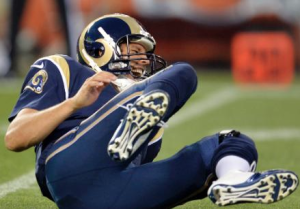
Performance Analytics Tackles Sports Injuries

In the human demolition derby known as the National Football League, season-ending, often career-threatening, injuries are already piling up like lineman on a loose football. And it’s only preseason!
An injury to a star player—the St. Louis Rams lost their starting quarterback Sam Bradford to his second torn ACL in as many years over the weekend—can ruin a team’s season before it begins. That translates into empty seats in stadiums, lost revenues from missing the playoffs and potentially years of expensive roster rebuilding.
Now, some sports executives are looking at a range of data-driven strategies including a variation on predictive analytics dubbed “performance analytics” in an attempt to survive the NFL’s annual battle of attrition. According to an item in the publication Fast Company, NFL players with an average salary of $2 million collectively missed a record 1,600 games in 2013. Along with Bradford, injured stars like Green Bay Packers quarterback Aaron Rodgers missed nearly half of last season with a broken collarbone.
Career-threatening injuries are among the reasons why NFL franchises shy away from guaranteeing money in huge multiyear contracts.
While some teams are adjusting their offseason regimens and practice schedules in an attempt to reduce serious injuries, others like the New England Patriots and Philadelphia Eagles are attempting to turn every body movement into data. The NFL’s equivalent of big data is being used in an attempt to spot injury-prone athletes or adjust the way professional athletes train.
Performance analytics is also being used in Major League Baseball, both as a means of gathering an analyzing data to reduce injuries as well as statistical tool. MLB is in the process of installing cameras and other sensors in big league ballparks that would make it possible to record practically every move made by every player during every game.
Hence, there is a lot of data to work with, and sports medicine specialists are increasingly interested in trying to leverage it to reduce injuries or spot injury-prone athletes who will end up costing professional franchises money.
The Patriots have been using analytics over the last decade for other applications like player evaluation. The franchise is credited with using performance data to spot the best college players at the lowest price.
The Patriots also hired an injury prevention consultant, Dr. Marcus Elliot, a sports science specialist trained at Harvard University. Elliot, founder and director of a sports science clinic called P3, also has served as baseball’s first director of sports science and performance with the Seattle Mariners.
P3’s approach uses techniques like 3-D motion capture to assess athletes, then prescribe training programs to correct biomechanical flaws. In a company testimonial, one pro athlete said P3’s approach help him learn how his body worked and how best to take care of it.
While professional football does not generate the mountains of statistical data that major league baseball churns out, NFL executives continue to look for new ways to generate data on player performance as a way to optimize their payrolls while identifying players who either through their style of play or position are less prone to injury.
Technology companies like chipmaker Intel Corp. are also eyeing the big data market for sports, especially with the epidemic of concussions throughout the ranks of football. Intel is touting sensor technology embedded in football helmets that can gather data on the impact and severity of head injuries in youth through professional football.
Intel said it is amassing data sets from football practices and games for implementing its big data effort. “Understanding the transfer of energy through a helmet and into the head in order to prevent brain damage is the goal,” according to Intel engineer Bill Hannon. “Football science” and other tools like performance analytics are producing growing amounts of data that can be used to reduce injuries, Intel claims.
In the meantime, NFL teams are trying to move beyond the mindset that injuries are part of the “cost of doing business.” Better equipment and training based on the insights provided by analytics can help keep rosters intact, but the growing speed and violence of the pro game is making it harder to keep high-paid stars on the field through the playoffs.
Recent items:
Giving Big Data a Sporting Chance


























